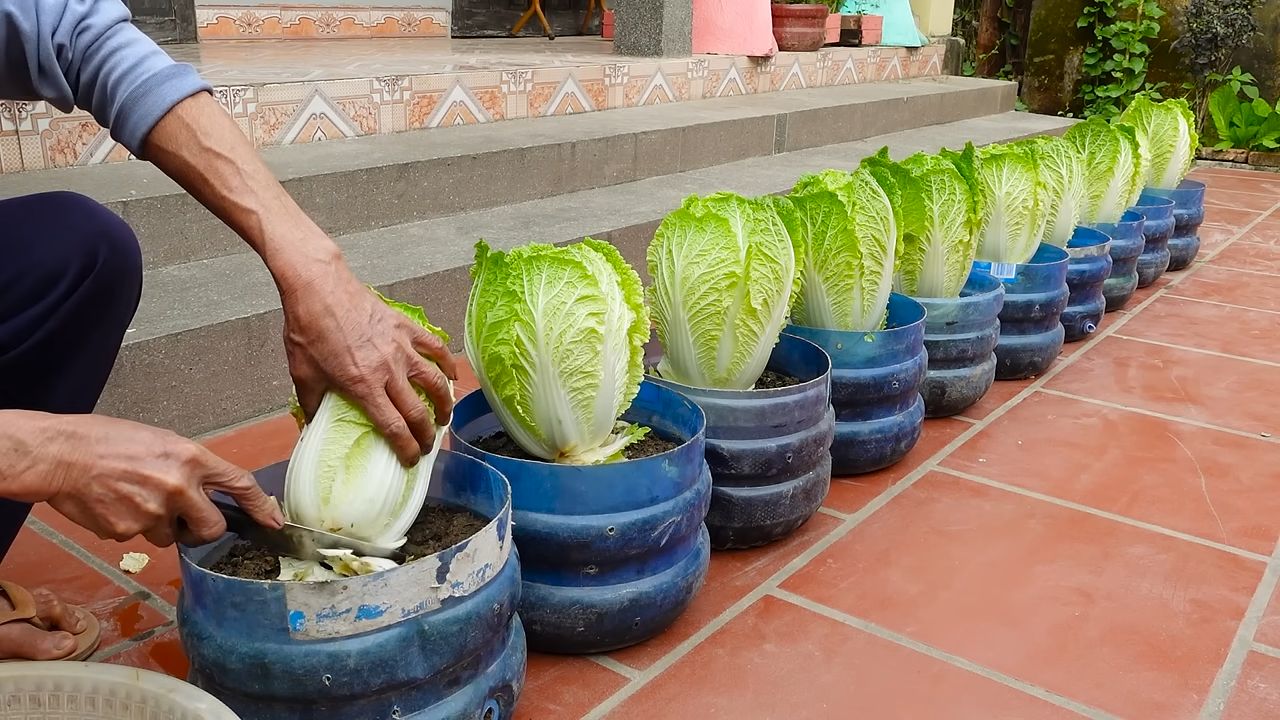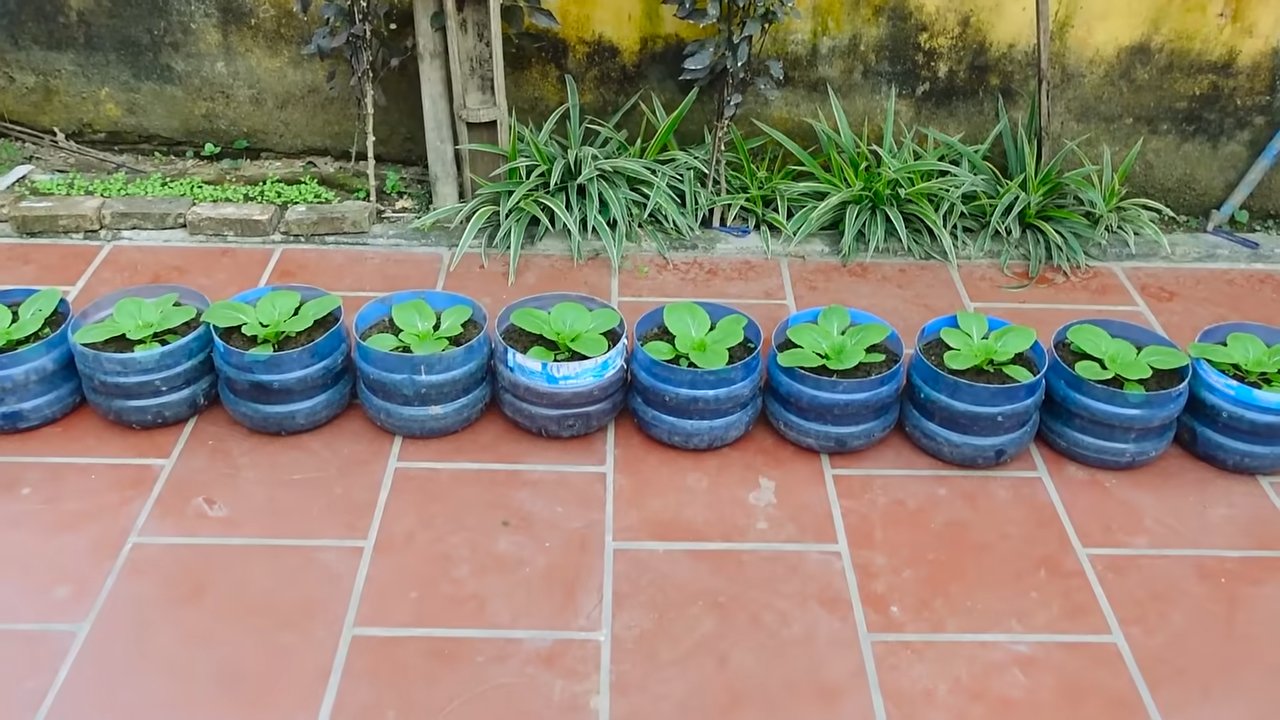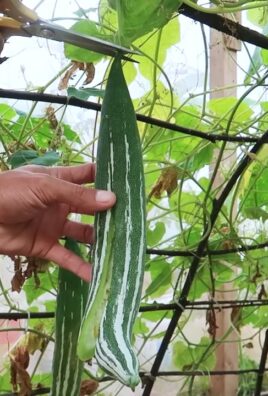Grow Chinese Cabbage Quickly? Absolutely! Imagine harvesting crisp, delicious Chinese cabbage from your own backyard in record time. Forget waiting months – with these simple DIY tricks and hacks, you can enjoy fresh, homegrown cabbage sooner than you think!
For centuries, Chinese cabbage has been a staple in Asian cuisine, prized for its versatility and nutritional value. From stir-fries to kimchi, this leafy green has nourished families and communities. But you don’t need to be a seasoned gardener to cultivate this amazing vegetable. I’m here to show you how to grow Chinese cabbage quickly, even if you’re a complete beginner.
Let’s face it, gardening can sometimes feel like a waiting game. We plant our seeds, water diligently, and then… we wait. But what if you could speed up the process and enjoy the fruits (or in this case, vegetables) of your labor much faster? That’s where these DIY tricks come in. Whether you’re short on space, time, or patience, these hacks will help you maximize your yield and minimize your waiting time. So, grab your gardening gloves, and let’s get started on your journey to a bountiful Chinese cabbage harvest!

Chinakohl blitzschnell anbauen: Dein DIY-Guide für eine rasche Ernte
Hey Gartenfreunde! Chinakohl ist ein super vielseitiges Gemüse, das in der Küche echt was hermacht. Aber wer hat schon ewig Zeit, auf die Ernte zu warten? Ich zeige dir, wie du deinen Chinakohl-Anbau so richtig beschleunigen kannst. Mit diesen Tricks und Kniffen kannst du schon bald frischen Chinakohl aus dem eigenen Garten genießen. Los geht’s!
Die Grundlagen: Was Chinakohl liebt
Bevor wir loslegen, lass uns kurz die Basics klären. Chinakohl ist ein Starkzehrer, das heißt, er braucht ordentlich Nährstoffe. Außerdem mag er es sonnig bis halbschattig und der Boden sollte locker und gut durchlässig sein. Staunässe ist ein absolutes No-Go!
* Standort: Sonnige bis halbschattige Lage
* Boden: Locker, durchlässig, humusreich
* Nährstoffe: Starkzehrer, braucht viel Dünger
* Wasser: Regelmäßig gießen, aber Staunässe vermeiden
Phase 1: Die Vorbereitung – Der Schlüssel zum Erfolg
Eine gute Vorbereitung ist die halbe Miete, das gilt auch beim Chinakohl-Anbau. Hier zeige ich dir, wie du den perfekten Start für deine Pflanzen schaffst.
1. Die richtige Sorte wählen
Es gibt verschiedene Chinakohl-Sorten, die sich in ihrer Reifezeit unterscheiden. Für eine schnelle Ernte solltest du zu Sorten greifen, die als “frühreif” gekennzeichnet sind. Frag am besten im Gartencenter nach, welche Sorten sich für deine Region eignen.
2. Vorkultur oder Direktsaat?
Ich empfehle dir die Vorkultur im Haus. Das hat mehrere Vorteile: Du kannst die Wachstumszeit verlängern, die Pflanzen sind robuster, wenn sie ins Freiland kommen, und du hast weniger Probleme mit Schädlingen.
* Vorkultur: Ab März im Haus vorziehen
* Direktsaat: Ab Mai ins Freiland säen
3. Die Aussaat im Haus (Vorkultur)
1. Aussaatgefäße vorbereiten: Nimm kleine Töpfe oder Anzuchtschalen und fülle sie mit Anzuchterde. Diese ist nährstoffarm und ideal für junge Pflanzen.
2. Samen aussäen: Lege pro Topf 2-3 Samen etwa 1 cm tief in die Erde.
3. Angießen: Befeuchte die Erde vorsichtig mit einer Sprühflasche. Vermeide Staunässe!
4. Warm stellen: Stelle die Töpfe an einen hellen und warmen Ort (ca. 18-20°C). Ein Mini-Gewächshaus oder eine durchsichtige Plastikhaube hilft, die Luftfeuchtigkeit hoch zu halten.
5. Feucht halten: Achte darauf, dass die Erde immer leicht feucht ist.
6. Pikieren: Sobald die Keimlinge ihre ersten richtigen Blätter (nach den Keimblättern) haben, kannst du sie pikieren. Das bedeutet, du setzt die stärksten Pflänzchen einzeln in größere Töpfe um.
4. Den Boden vorbereiten
Während deine kleinen Chinakohl-Pflänzchen im Haus wachsen, kannst du den Boden im Garten vorbereiten.
1. Boden lockern: Grabe den Boden gründlich um und entferne Unkraut und Steine.
2. Kompost einarbeiten: Chinakohl liebt nährstoffreichen Boden. Arbeite großzügig Kompost oder gut verrotteten Mist in den Boden ein.
3. Düngen: Zusätzlich kannst du einen organischen Dünger (z.B. Hornspäne) einarbeiten.
4. Boden glätten: Harke den Boden glatt, damit er bereit für die Pflanzung ist.
Phase 2: Die Pflanzung – Ab ins Freiland!
Sobald die Chinakohl-Pflänzchen kräftig genug sind (ca. 10-15 cm hoch), können sie ins Freiland umziehen. Das ist meistens ab Mitte Mai der Fall, wenn keine Frostgefahr mehr besteht.
1. Abhärten
Bevor du die Pflanzen ins Freiland setzt, solltest du sie ein paar Tage lang abhärten. Das bedeutet, du stellst sie tagsüber für ein paar Stunden nach draußen, damit sie sich an die Sonne und die Temperaturen gewöhnen können.
2. Pflanzlöcher vorbereiten
1. Abstand: Grabe Pflanzlöcher im Abstand von ca. 30-40 cm.
2. Tiefe: Die Pflanzlöcher sollten so tief sein, dass die Wurzelballen der Pflanzen gut hineinpassen.
3. Pflanzen einsetzen
1. Vorsichtig aus dem Topf nehmen: Nimm die Pflanzen vorsichtig aus ihren Töpfen und achte darauf, die Wurzeln nicht zu beschädigen.
2. Einsetzen: Setze die Pflanzen in die Pflanzlöcher und fülle diese mit Erde auf.
3. Andrücken: Drücke die Erde leicht an.
4. Angießen: Gieße die Pflanzen gründlich an.
4. Schutzmaßnahmen
Junge Chinakohl-Pflanzen sind besonders anfällig für Schädlinge wie Kohlfliegen und Erdflöhe. Hier sind ein paar Tipps, wie du sie schützen kannst:
* Schutznetz: Decke die Pflanzen mit einem feinmaschigen Schutznetz ab. Das hält Schädlinge fern und schützt vor starker Sonneneinstrahlung.
* Kohlkragen: Lege einen Kohlkragen aus Pappe oder Kunststoff um die Pflanzen. Das verhindert, dass die Kohlfliege ihre Eier an den Wurzeln ablegt.
* Natürliche Schädlingsbekämpfung: Spritze die Pflanzen regelmäßig mit einem Sud aus Brennnesseln oder Rainfarn. Das stärkt die Pflanzen und wehrt Schädlinge ab.
Phase 3: Die Pflege – Damit dein Chinakohl prächtig gedeiht
Nach der Pflanzung ist es wichtig, den Chinakohl gut zu pflegen, damit er schnell wächst und eine reiche Ernte bringt.
1. Gießen
Chinakohl braucht regelmäßig Wasser, besonders in trockenen Perioden. Achte darauf, dass der Boden immer leicht feucht ist, aber vermeide Staunässe. Gieße am besten morgens oder abends, damit das Wasser nicht so schnell verdunstet.
2. Düngen
Da Chinakohl ein Starkzehrer ist, solltest du ihn regelmäßig düngen. Verwende am besten einen organischen Dünger (z.B. Gemüsedünger) und halte dich an die Dosierungsanleitung auf der Verpackung. Dünge alle 2-3 Wochen.
3. Unkraut entfernen
Halte den Boden um die Chinakohl-Pflanzen herum unkrautfrei. Unkraut konkurriert mit den Pflanzen um Nährstoffe und Wasser.
4. Boden lockern
Lockere den Boden regelmäßig auf, damit er gut belüftet ist. Das fördert das Wachstum der Pflanzen.
5. Schädlinge und Krankheiten bekämpfen
Beobachte deine Chinakohl-Pflanzen regelmäßig auf Schädlinge und Krankheiten. Bei Befall solltest du schnell handeln, um eine Ausbreitung zu verhindern.
* Kohlweißling: Sammle die Raupen ab oder verwende ein biologisches Insektizid.
* Kohlhernie: Achte auf eine gute Fruchtfolge und vermeide den Anbau von Kohlgewächsen auf derselben Fläche über mehrere Jahre.
* Falscher Mehltau: Sorge für eine gute Belüftung der Pflanzen und vermeide Staunässe.
Phase 4: Die Ernte – Endlich frischer Chinakohl!
Je nach Sorte und Witterung kannst du deinen Chinakohl etwa 6-8 Wochen nach der Pflanzung ernten. Der Kopf sollte fest und geschlossen sein.
1. Erntezeitpunkt
Der beste Zeitpunkt für die Ernte ist, wenn der Kopf fest und geschlossen ist. Drücke leicht auf den Kopf. Wenn er sich fest anfühlt, ist er reif.
2. Erntemethode
Schneide den Kopf mit einem scharfen Messer knapp über dem Boden ab. Entferne die äußeren Blätter, die möglicherweise beschädigt sind.
3. Lagerung
Chinakohl lässt sich im Kühlschrank einige Tage lagern. Wickle ihn am besten in ein feuchtes Tuch, damit er nicht austrocknet. Du kannst ihn

Conclusion
So, there you have it! Growing Chinese cabbage quickly doesn’t have to be a daunting task reserved for seasoned gardeners. With these simple yet effective DIY tricks, you can transform your garden into a thriving haven for this delicious and versatile vegetable. We’ve explored the importance of starting with the right seeds, optimizing soil conditions, providing adequate sunlight and water, and protecting your precious plants from pests and diseases. Each of these elements plays a crucial role in accelerating the growth process and ensuring a bountiful harvest.
But why is this DIY approach a must-try? Because it empowers you to take control of your food source, enjoy fresher, healthier produce, and save money in the long run. Store-bought Chinese cabbage often lacks the vibrant flavor and crisp texture of homegrown varieties. Plus, you can be confident that your DIY Chinese cabbage is free from harmful pesticides and chemicals.
Beyond the basic techniques we’ve discussed, there are plenty of ways to customize your approach. Consider experimenting with different companion plants, such as marigolds or nasturtiums, to naturally deter pests. You could also try using a cold frame or row covers to extend the growing season and protect your plants from frost. For those with limited space, container gardening is an excellent option. Choose a large pot with good drainage and follow the same principles of soil preparation, watering, and fertilization.
Don’t be afraid to get creative and adapt these techniques to suit your specific environment and preferences. The key is to observe your plants closely and respond to their needs. Are the leaves wilting? They might need more water. Are pests attacking? Take action immediately with organic pest control methods.
We are confident that you will be amazed by the results. Imagine the satisfaction of harvesting your own crisp, flavorful Chinese cabbage, ready to be used in stir-fries, salads, soups, and countless other dishes. The possibilities are endless!
Now, it’s your turn to put these DIY tricks into action. We encourage you to embark on this rewarding gardening journey and experience the joy of growing your own Chinese cabbage quickly. And most importantly, we want to hear about your experiences! Share your tips, successes, and challenges in the comments below. Let’s create a community of passionate gardeners who are dedicated to growing delicious and healthy food. Your insights could inspire others and help them achieve their gardening goals. So, grab your seeds, get your hands dirty, and let’s grow some amazing Chinese cabbage together!
Frequently Asked Questions (FAQ)
What is the best time of year to plant Chinese cabbage for quick growth?
The ideal time to plant Chinese cabbage depends on your climate. Generally, it’s best to plant in late summer or early fall for a fall harvest. This allows the plants to mature in cooler temperatures, which are essential for preventing bolting (premature flowering). In regions with mild winters, you can also plant in early spring for a spring harvest. However, be mindful of potential heat waves that could trigger bolting. Check your local climate data and seed packet instructions for specific recommendations.
How much sunlight does Chinese cabbage need to grow quickly?
Chinese cabbage thrives in full sun, which means at least 6 hours of direct sunlight per day. Adequate sunlight is crucial for photosynthesis, the process by which plants convert sunlight into energy for growth. If you live in a particularly hot climate, providing some afternoon shade can help prevent the leaves from scorching. However, avoid planting in areas that are consistently shaded, as this will significantly slow down growth.
What type of soil is best for growing Chinese cabbage quickly?
Chinese cabbage prefers well-drained, fertile soil that is rich in organic matter. The ideal soil pH is between 6.0 and 7.5. Before planting, amend your soil with compost, aged manure, or other organic materials to improve its structure, drainage, and nutrient content. Avoid heavy clay soils, as they can become waterlogged and hinder root growth. If you have clay soil, consider adding sand and organic matter to improve drainage.
How often should I water Chinese cabbage to promote rapid growth?
Consistent watering is essential for growing Chinese cabbage quickly. Aim to keep the soil consistently moist but not waterlogged. Water deeply whenever the top inch of soil feels dry to the touch. The frequency of watering will depend on factors such as weather conditions, soil type, and plant size. During hot, dry periods, you may need to water daily. Mulching around the plants can help retain moisture in the soil and reduce the need for frequent watering.
What are some common pests and diseases that affect Chinese cabbage, and how can I prevent them?
Chinese cabbage is susceptible to various pests and diseases, including aphids, cabbage worms, flea beetles, and clubroot. To prevent these problems, practice good garden hygiene, such as removing plant debris and weeds that can harbor pests and diseases. Use row covers to protect young plants from insect infestations. Inspect your plants regularly for signs of pests or diseases and take action promptly. Organic pest control methods, such as insecticidal soap or neem oil, can be effective against many common pests. To prevent clubroot, ensure your soil is well-drained and avoid planting Chinese cabbage in the same location year after year. Crop rotation is a key strategy for preventing soilborne diseases.
How do I know when my Chinese cabbage is ready to harvest?
Chinese cabbage is typically ready to harvest when the heads are firm and compact. The exact size and shape of the heads will vary depending on the variety. Check the seed packet for specific information on the expected size and maturity time. To harvest, simply cut the head off at the base with a sharp knife. You can also harvest individual leaves as needed, but this will slow down the overall growth of the plant.
Can I grow Chinese cabbage in containers?
Yes, Chinese cabbage can be successfully grown in containers, especially if you have limited garden space. Choose a large container with good drainage holes. A container that is at least 12 inches in diameter and 12 inches deep is recommended. Use a high-quality potting mix that is well-draining and rich in organic matter. Follow the same principles of watering, fertilization, and pest control as you would for growing Chinese cabbage in the ground. Container-grown plants may require more frequent watering and fertilization, as the soil in containers tends to dry out more quickly.
What are some good companion plants for Chinese cabbage?
Companion planting can be a beneficial strategy for growing Chinese cabbage. Some good companion plants include:
* **Marigolds:** These flowers deter many common pests, such as nematodes and aphids.
* **Nasturtiums:** These edible flowers attract beneficial insects and repel aphids and cabbage worms.
* **Dill:** This herb attracts beneficial insects and repels cabbage moths.
* **Garlic:** This pungent bulb repels many pests and can help prevent fungal diseases.
* **Onions:** Similar to garlic, onions can deter pests and improve soil health.
Avoid planting Chinese cabbage near members of the brassica family, such as broccoli, cauliflower, and kale, as they can attract the same pests and diseases.
How can I prevent Chinese cabbage from bolting (premature flowering)?
Bolting is a common problem with Chinese cabbage, especially in hot weather. To prevent bolting, choose bolt-resistant varieties, plant at the appropriate time of year, and provide adequate water and shade. Mulching around the plants can help keep the soil cool and moist. If you notice signs of bolting, such as the development of a flower stalk, harvest the cabbage immediately, as the leaves will become bitter and tough.
Is it possible to grow Chinese cabbage indoors?
While it’s possible to start Chinese cabbage seeds indoors, it’s generally not recommended to grow them to full maturity indoors. Chinese cabbage requires a lot of sunlight and space to thrive, which can be difficult to provide indoors. However, you can start seeds indoors 4-6 weeks before the last expected frost and then transplant them outdoors once the weather warms up. Use grow lights to supplement natural sunlight and ensure the seedlings receive adequate light.




Leave a Comment